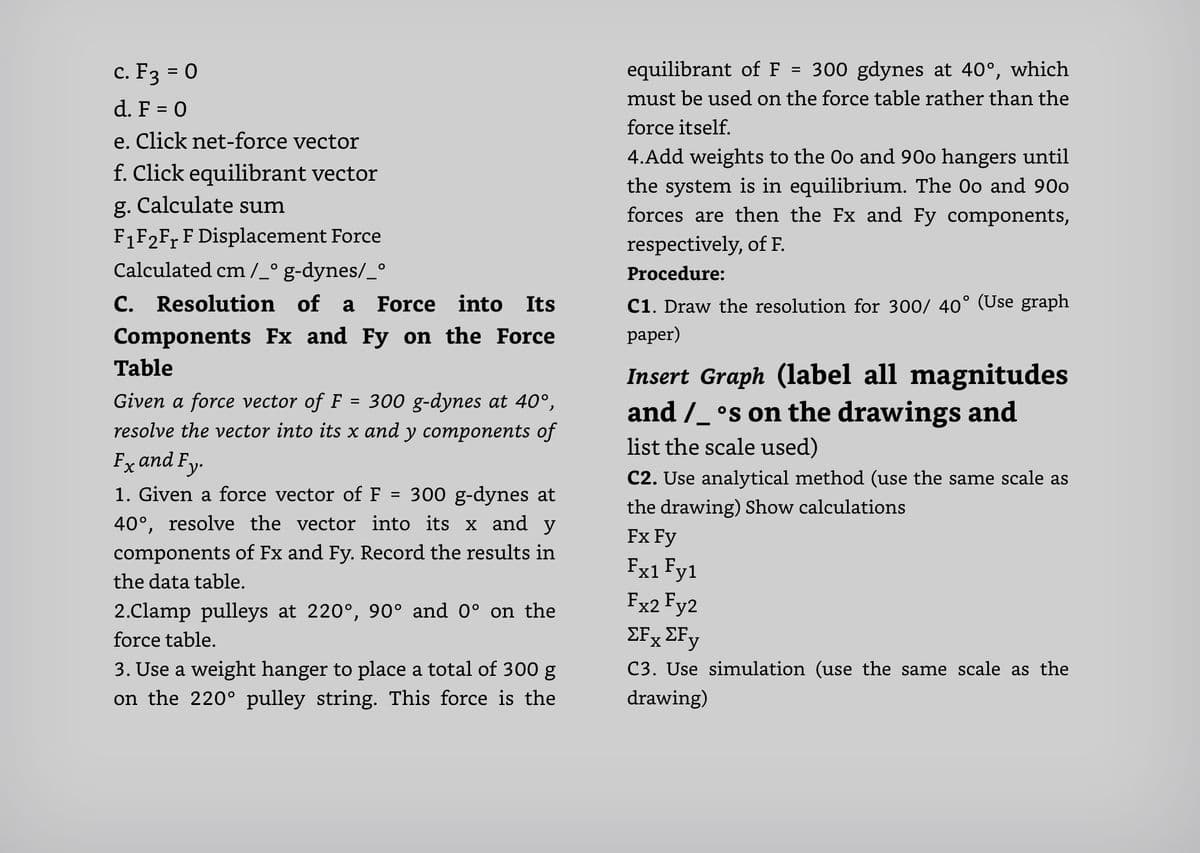c. F3 = 0 equilibrant ofF = 300 gdynes at 40°, which must be used on the force table rather than the d. F = 0 force itself. e. Click net-force vector 4.Add weights to the Oo and 90o hangers until the system is in equilibrium. The Oo and 90o forces are then the Fx and Fy components, f. Click equilibrant vector g. Calculate sum F1F2FF F Displacement Force Calculated cm/_° g-dynes/_° C. Resolution of a Components Fx and Fy on the Force respectively, of F. Procedure: Force into Its c1. Draw the resolution for 300/ 40° (Use graph рaper) Table Given a force vector of F = 300 g-dynes at 40°, resolve the vector into its x and y components of Insert Graph (label all magnitudes and /_ °s on the drawings and list the scale used) Fx and Fy. C2. Use analytical method (use the same scale as 1. Given a force vector of F = 300 g-dynes at 40°, resolve the vector into its x and y the drawing) Show calculations Fx Fy components of Fx and Fy. Record the results in Fx1 Fy1 Fx2 Fy2 ΣΕχ ΣΕy the data table. 2.Clamp pulleys at 220°, 90° and 0° on the force table. 3. Use a weight hanger to place a total of 300 g on the 220° pulley string. This force is the C3. Use simulation (use the same scale as the drawing)
c. F3 = 0 equilibrant ofF = 300 gdynes at 40°, which must be used on the force table rather than the d. F = 0 force itself. e. Click net-force vector 4.Add weights to the Oo and 90o hangers until the system is in equilibrium. The Oo and 90o forces are then the Fx and Fy components, f. Click equilibrant vector g. Calculate sum F1F2FF F Displacement Force Calculated cm/_° g-dynes/_° C. Resolution of a Components Fx and Fy on the Force respectively, of F. Procedure: Force into Its c1. Draw the resolution for 300/ 40° (Use graph рaper) Table Given a force vector of F = 300 g-dynes at 40°, resolve the vector into its x and y components of Insert Graph (label all magnitudes and /_ °s on the drawings and list the scale used) Fx and Fy. C2. Use analytical method (use the same scale as 1. Given a force vector of F = 300 g-dynes at 40°, resolve the vector into its x and y the drawing) Show calculations Fx Fy components of Fx and Fy. Record the results in Fx1 Fy1 Fx2 Fy2 ΣΕχ ΣΕy the data table. 2.Clamp pulleys at 220°, 90° and 0° on the force table. 3. Use a weight hanger to place a total of 300 g on the 220° pulley string. This force is the C3. Use simulation (use the same scale as the drawing)
Related questions
Question
Please answer this question as soon as possible

Transcribed Image Text:c. F3 = 0
d. F = 0
equilibrant of F
300 gdynes at 40°, which
%3D
%3D
must be used on the force table rather than the
force itself.
e. Click net-force vector
f. Click equilibrant vector
g. Calculate sum
4.Add weights to the Oo and 90o hangers until
the system is in equilibrium. The Oo and 90o
forces are then the Fx and Fy components,
F1F2Fr F Displacement Force
respectively, of F.
Calculated cm /_° g-dynes/_°
Procedure:
C. Resolution of
a Force into Its
C1. Draw the resolution for 300/ 40° (Use graph
Components Fx and Fy on the Force
рaper)
Table
Given a force vector of F
resolve the vector into its x and y components of
Fx and Fy.
Insert Graph (label all magnitudes
and /_ °s on the drawings and
list the scale used)
300 g-dynes at 40°,
%3D
C2. Use analytical method (use the same scale as
1. Given a force vector of F
300 g-dynes at
the drawing) Show calculations
Fx Fy
40°, resolve the vector into its x and y
components of Fx and Fy. Record the results in
Fx1 Fy1
Fx2 Fy2
EFx EFy
the data table.
2.Clamp pulleys at 220°, 90° and 0° on the
force table.
C3. Use simulation (use the same scale as the
3. Use a weight hanger to place a total of 300 g
on the 220° pulley string. This force is the
drawing)
Expert Solution
This question has been solved!
Explore an expertly crafted, step-by-step solution for a thorough understanding of key concepts.
This is a popular solution!
Trending now
This is a popular solution!
Step by step
Solved in 2 steps with 1 images
